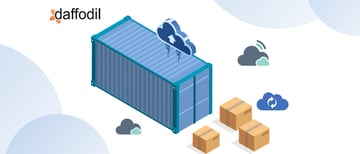-4.jpg?width=700&name=blog%20banner%20(2)-4.jpg)
The software development business is witnessing an ever-increasing adoption of various cloud-native methods for deploying applications, and containerization is one of the most sought-after of these methods. This has, however, opened up organizations using containers to potential cyber-attacks and other vulnerabilities, therefore promoting the need for container security.
With proper container security, businesses using the DevOps workflow can avoid putting customer data at risk and losing millions from unaccounted oversight. Organizations stand to face a liquidity crisis if potential penalties and a dip in productivity and sales caused by a cyber attack are not covered intuitively.
The market analysis aggregator ResearchDive predicts that the global container security market may accumulate close to $ 7,000 million by 2028, at a steady CAGR of 23.3%. As the market grows, so does the magnitude of losses amassed by lukewarm container security contingencies.
Further ahead, you will find out what container security is and why enterprises need to invest in it. We will then discuss how it is implemented according to the industry best practices.
What Is Container Security?
Before we define container security, we need to understand what containers are. A container is a standard software unit that combines code and all the dependencies required to run an application deployed in a containerization platform such as Docker. In short, a container consists of an entire runtime environment.
Containers are extensively used by technology companies working with the DevOps methodology for developing, running, testing, and deploying various applications. For running in an isolated environment or operating system, the executable code of the application is packaged into a static, lightweight file known as a container image.
There are a variety of attacks that can occur during the process wherein the container dependencies are imported into the container image. These usually arise when the dependencies or libraries are not fully secured. As containers need container images to construct a run-time environment for the application, an attack on the container image means that the run-time environment is at risk.
The Sysdig Container Security And Usage Report 2021 revealed that about 58% of container images are overtly vulnerable, although a lot of security measures are being set in place. It is evident from this report that there is still a lot to be done when it comes to securing containerization platforms.
To ensure that the run-time environment is shielded against cyber attacks, there are two ways to set up the container security measures:
Configure container image security: By regularly updating the container image, you can ensure that it is updated with the latest security patches. New privileges should not be granted frequently, resource quotas should be well-defined and the images should be lightweight.
Configure container at run-time: Under this option, the container should be hosted in an environment that minimizes the overall attack surface area for the hosted application. Additionally, the health of your hosting platform should be monitored regularly.
Customer Success Story: Reengineering mobile app for ACKO, India’s first and fastest-growing InsurTech company
Why Is Container Security Essential?
The integrity of the deployed application as well as overall enterprise security are closely tied to how secure your containers are. The slightest of breaches can be caused by malicious code, development irregularities, or a software supply chain attack. Some of the main reasons that make container security a necessity are:
- Most containers are created with resources, libraries, dependencies, and code that is publicly accessible. This is enough to attract all sorts of cyberattacks that can put essential customer data and application integrity at risk.
- There is the widespread use of open-source code in containerized applications. As open-source code does not involve too many layers of validation, it is often vulnerable to threats. Very often the code also contains the IP address of the organization which is accessible to attackers through occasional remote procedure calls. This can give them access to the organization's cloud environment.
- As these enterprises work within the agile framework, developers are often pressed for time, delivering a product that has skipped a few security stages. Adhering to strict deadlines can often cause oversights which can be completely avoided if due diligence is given to security protocols before the application is deployed. The entire build lifecycle for the application should ideally go through stages of regular security checks.
- Keeping track of resources is difficult for organizations due to the sheer abundance of tools and plug-ins that are supported by containers. Updating security patches with all of these dependencies means providing new security patches for each and every tool that is linked to the primary application.
How Are Container Security Measures Implemented?
Containers require a robust set of monitoring tools and container-focused configurations for the underlying operating system. Container security must be a holistic security implementation approach that takes into account customer data, host health, application health, as well as access control. The primary implementation measures for container security are listed below:
1)Clean Up Code: There is always a possibility that the code you write is replete with notes that may contain information that may actually be confidential to your organization. The code or the config file may have secrets such as passwords, trade secrets, or other confidential information that may get into the wrong hands. So, it is best to write programs that consist of purely executable lines of code and nothing else.
2)Container Image Hardening: Hardening of container images consists of identifying weaknesses and limiting them. The current security status of these images is analyzed and existing vulnerabilities are then reduced. You can also find pre-hardened container images from the Center for Internet Security (CIS).
3)Testing Images Through Pipeline: Throughout the deployment pipeline or CI/CD pipeline, you can use static application security testing tools to monitor every step in the versioning of the code. Each compiled version of the code can be analyzed manually or dynamic application security testing can be implemented for enabling automated workflows. SQL injection, command injection, and insecure server configuration are some of the security flaws that may come up.
4)Production Transparency: You must always look into tools that provide detailed transparency to the resources being deployed and shared. Resource consumption in containers can give you a clear picture of container performance and application health. With the appropriate tool, you can keep a close eye on the metrics and activity logs of each container and container image.
ALSO READ: A DevSecOps Checklist to Secure DevOps Pipeline
Leverage The Right Tools To Ensure Container Security
There are several tools that help with container security but leveraging the right tools makes all the difference. Factors you must ensure for optimum container security include comprehensive visibility, automated analysis of metrics, regular logging, and a flat learning curve. With Daffodil's DevOps Services, you can ensure that the best tools are employed for your CI/CD pipeline.
ALSO READ: A CTO's Guide to DevOps and its Services



